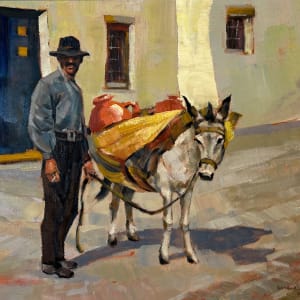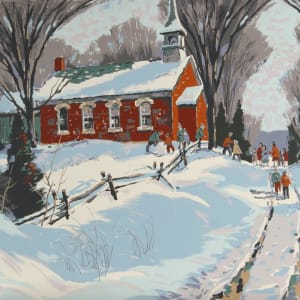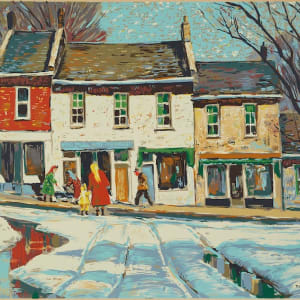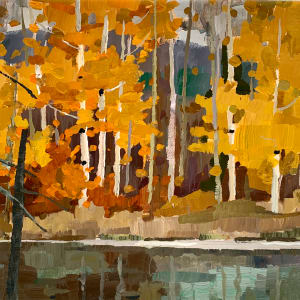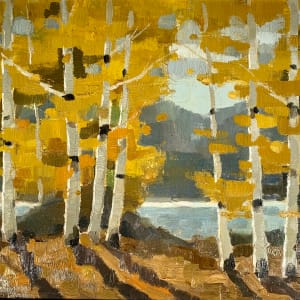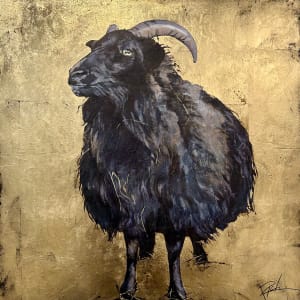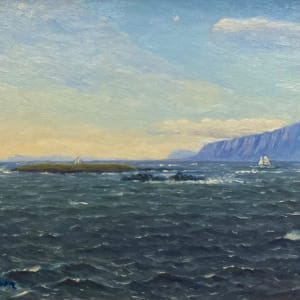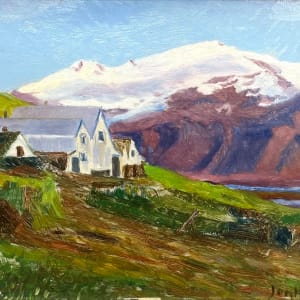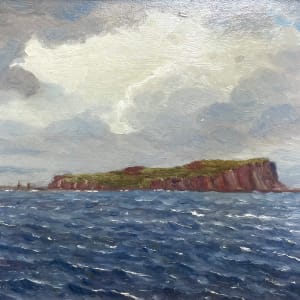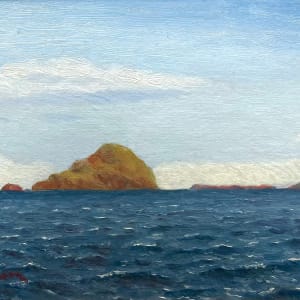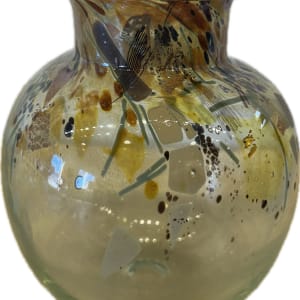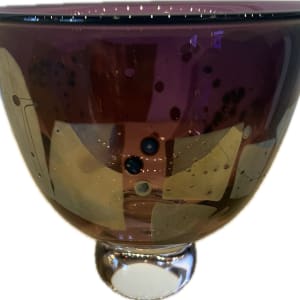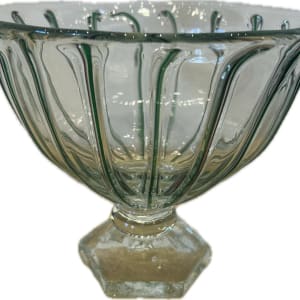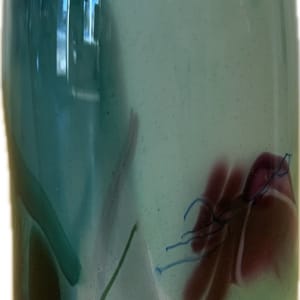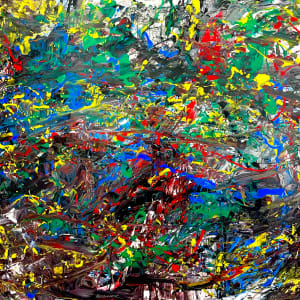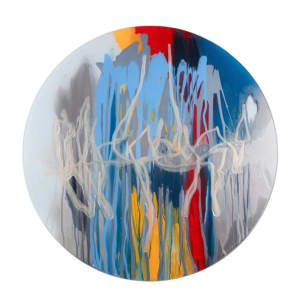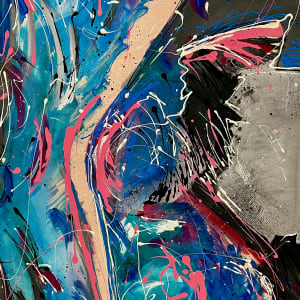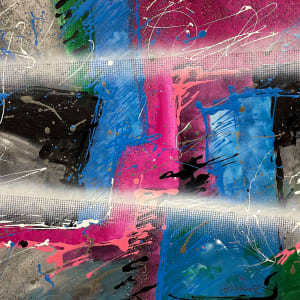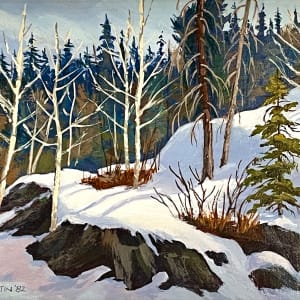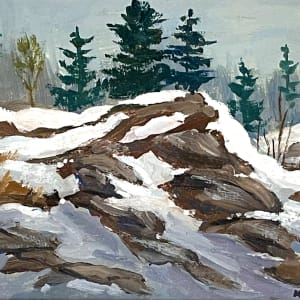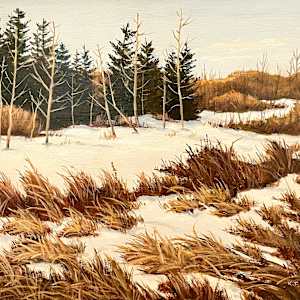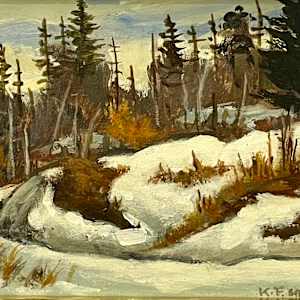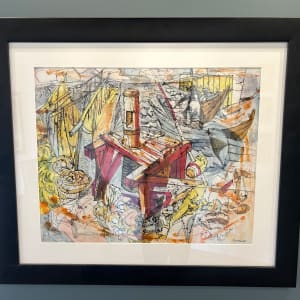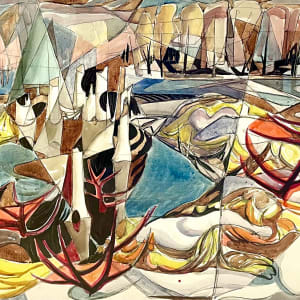Emil Barbarini (1855-1930) Austria
Emil Barbarini (1855-1933) was an Austrian painter, born in Vienna as the son of the renowned landscape artist Franz Barbarini. While his father focused on alpine themes, Emil developed a distinctive style centered around the bustling life of market scenes. His favorite subject was the flower market in front of the Karlskirche in Vienna, though his travels to the Netherlands and Belgium also inspired numerous market depictions. Influenced by French artists such as Degas and Monet, Barbarini was particularly drawn to capturing the nuances of light at various times of the day, exploring its effect on the vibrancy of his subjects. His work is celebrated for its lively depiction of everyday life and the atmospheric use of light.
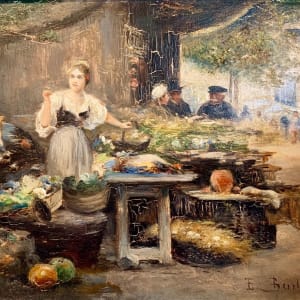
Tom Roberts (1909-1998)
Thomas Keith Roberts (1909–1998) was a Canadian painter celebrated for his vivid landscapes and nostalgic depictions of rural life. Born in Toronto, Ontario, he was immersed in the artistic world of the Roberts Gallery, founded by his grandfather, Samuel Roberts. He studied at Central Technical School and the Ontario College of Art, where he learned from notable artists such as J.W. Beatty, F.S. Challener, and Carl Schaefer.
During World War II, Roberts served in the Royal Canadian Engineers, documenting army life through sketches and watercolours. His post-war paintings, inspired by French Impressionism and the Group of Seven, captured the landscapes of Northern Ontario, the Maritimes, and the Laurentians, often featuring children at play and serene townscapes. A member of the Royal Canadian Academy and Ontario Society of Artists, he exhibited widely, holding over thirty solo shows in Toronto throughout the 1980s. His work remains a cherished part of Canadian art history.
Thoreau MacDonald (1901-1989)
Thoreau MacDonald (1901–1989) was a Canadian illustrator, graphic designer, and artist, best known for his black-and-white illustrations due to his color blindness. Son of Group of Seven member J. E. H. MacDonald, he was self-taught but worked closely with his father in commercial design. His work spanned book design, illustration, and lettering, notably for Ryerson Press, Macmillan Company, and his own Woodchuck Press (1933–1946). His illustrations for Maria Chapdelaine (1938) were among his finest. MacDonald's art is held in collections such as the National Gallery of Canada and the McMichael Canadian Art Collection. His former home and garden in Vaughan, Ontario, donated in 1974, is now open to the public.
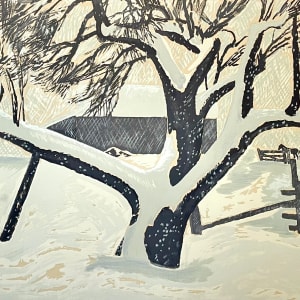
Peter Mcfarlane
Peter McFarlane is an award-winning artist based on Salt Spring Island, known for transforming discarded objects into thought-provoking artworks. His practice revolves around repurposing obsolete materials, re-contextualizing them to evoke personal and intellectual responses. With a belief that "waste is just a lack of imagination," McFarlane draws inspiration from history, recycling, and serendipity. His work is featured in public and private collections both nationally and internationally, offering viewers a fresh perspective on everyday objects and their potential for new meaning.
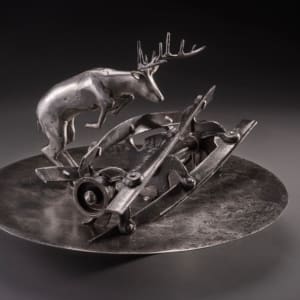
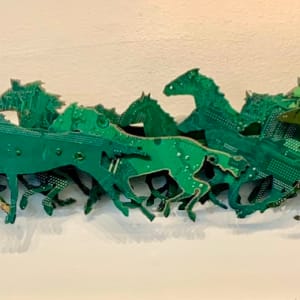
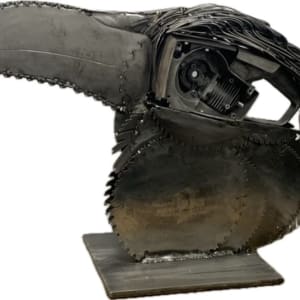
Ione Thorkelsson
Ione Thorkelsson (1947–) is one of Canada’s leading glass artists, known for her innovative cast glass sculptures. After studying architecture and working in theatre and ballet, Thorkelsson discovered glass in 1973 and established her first studio. Initially creating blown glass vessels, she shifted to kiln-fired cast glass in the early 2000s. Her work often incorporates natural forms like skulls, feathers, and roots, which she uses to create unique, ambiguous pieces that explore the intersection of beauty and morbidity. Thorkelsson has exhibited internationally and received numerous accolades, including induction into the Royal Canadian Academy of Arts (2007) and the Governor General’s Saidye Bronfman Award (2010). Her works are featured in public collections, including at the James Armstrong Richardson International Airport and the Canadian Embassy in Hong Kong.
Rand Heidinger
Rand Heidinger is a visual mixed-media artist with nearly three decades of experience creating commissioned works tailored to specific spaces. His art is defined by its attention to size, scale, depth, texture, and color, ensuring each piece harmonizes with its environment.
Heidinger’s creative process is highly collaborative, allowing clients to see how his vision can integrate with their ideas and surroundings. His dedication to craftsmanship and innovation has earned him notable recognition, including the honor of being selected as a Canadian visual artist to participate in a tribute to HRH Prince Philip in London, England, where he presented one of his original paintings at Buckingham Palace.
For those looking to bring unique, customized artwork into their space, Heidinger’s work offers a dynamic blend of texture, form, and color designed to make a lasting impact.
Eddy Cobiness (1933-1996)
Eddy Cobiness (July 17, 1933 – January 1, 1996) was an Ojibwe-Canadian artist renowned for his depiction of outdoor scenes and nature, reflecting his deep connection to the land. Born on the Buffalo Point First Nation reserve in southeast Manitoba, Cobiness was a prominent member of the "Indian Group of Seven," a collective that championed Indigenous art in Canada. He began his artistic journey by drawing birds as a child, later discovering watercolour painting during his military service in the 1950s. Cobiness initially worked in realistic styles but evolved into abstraction, influenced by his contemporaries, including Benjamin Chee Chee. His work gained international acclaim, with pieces in collections such as that of Queen Elizabeth II. Cobiness's innovative use of color and composition earned him recognition, and his art continues to influence Indigenous artists today. He passed away in Winnipeg in 1996.
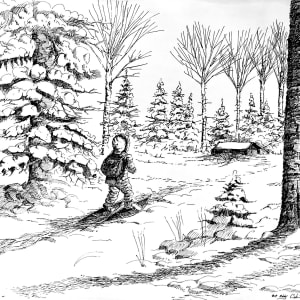
Clemence Wescoupe (1951-2018)
Clemence Wescoupe (1951–2018), a Saulteaux artist from Long Plain First Nation, was a founding member of the Woodland School of Art. Known for his graceful, flowing lines and stylized forms, Wescoupe developed his signature style after years of self-teaching. His iconic piece, Rainbirds (1977), became one of the most popular Woodland Aboriginal prints. Wescoupe’s work was featured in numerous solo and group exhibitions across Canada, Europe, and the U.S., including shows at the Winnipeg Art Gallery and the University of Heidelberg. His art, focused on spiritual guardianship and nature, is held in several prestigious collections, including the Canadian Museum of History and the Art Gallery of Nova Scotia.
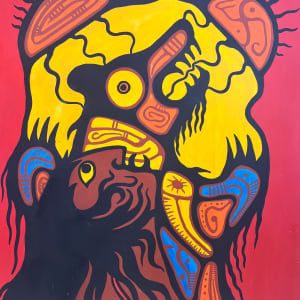
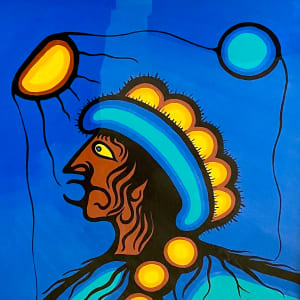
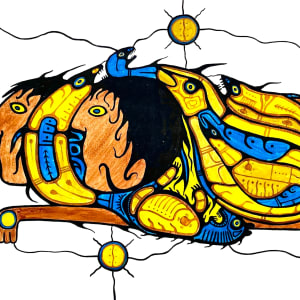
Kenneth Martin (1914-2010)
Kenneth Martin was a renowned Manitoba landscape artist, known for his meticulous oils, acrylics, and watercolors capturing the beauty of the Manitoba prairie, the Whiteshell, and Northwestern Ontario. He was particularly drawn to the ever-changing shores of Lake Winnipeg, where he and his wife, Fran, built a cottage in the 1950s.
Educated at Isaac Brock, Daniel McIntyre, and the Winnipeg School of Art, Ken’s artistic career was interrupted by his service as an aerial photographer in the RCAF during World War II. After the war, he became Art Director at Brigden's of Winnipeg, where he had apprenticed in 1938, before retiring early to focus on painting full-time.
Influenced by Lemoine Fitzgerald and the Group of Seven, Ken’s work hangs in public and private collections across Canada, the United States, and Europe. A passionate educator, he was a past president and honorary member of the Manitoba Society of Artists, where he inspired others through workshops and sketching trips with friends like Leo Mol and Spence Allison.
Clyde Finlay
Clyde Finlay is an international artist based in Winnipeg, Manitoba. After retiring from a long career in the Justice Department, he pursued Fine Arts, actively engaging in education, workshops, and presentations globally. With a diverse range of mediums and styles, Finlay has exhibited in Canada, the U.S., and Europe. His work has been featured in local publications like the Winnipeg Free Press and The Uniter, and he has appeared in numerous interviews and television programs. Finlay’s passion for art extends beyond creation, as he has contributed to various studies and research, participating in international art excursions with institutions like the University of Manitoba and the Winnipeg Art Gallery.
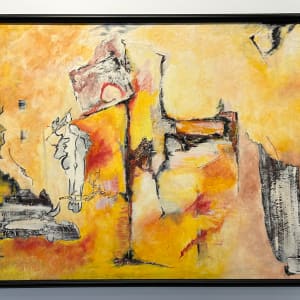
Ernest J. Hutchins (Circa 1880-1935)
Ernest John Hutchins was an English-born artist, likely born around 1880, who made a significant contribution to Canadian art during his time in Manitoba and the Canadian Rockies between 1909 and 1912. Specializing in historical images, Hutchins often drew inspiration from earlier works, incorporating scenes from the rich history of Canada's landscape and heritage. Notably, many of his paintings depicted important sites such as Upper Fort Garry and Lower Fort Garry, capturing the essence of these historical locations.
In 1904, Hutchins married Gertrude Mable Milnes in Middlesex County, England, and together they had four children: Lily, Mildred, Edna, and John. Hutchins passed away on June 8, 1935, leaving behind a legacy of artworks that continue to reflect his deep connection to Canada's history and its visual storytelling.
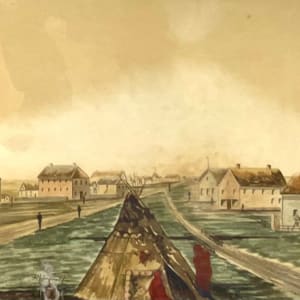
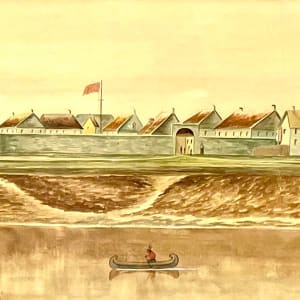
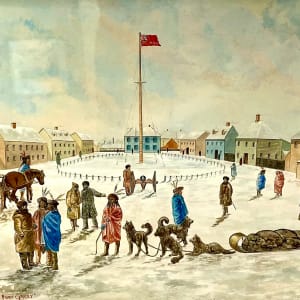
Simon Hughes
Simon Hughes (b. 1973, Winnipeg, Manitoba) is a Canadian artist known for his whimsical yet critical explorations of regionalism, modernism, and Canadian identity. Working primarily in watercolour, collage, and mixed media, Hughes creates imagined northern landscapes and urban environments, blending influences from Canadian abstraction, childhood nostalgia, and contemporary visual culture.
His work reinterprets the Canadian abstract canon, drawing inspiration from Paul Klee, Arthur Dove, and Claude Tousignant. Through his fantastical architectural renderings, he envisions playful, modular cityscapes populated by "sticker" people, engaging in a dialogue about stereotypes and contemporary Canadian communities.
Hughes' large-scale multi-paneled watercolours and video installations have been exhibited at the National Gallery of Canada, Winnipeg Art Gallery, Plug In ICA, and internationally at museums and film festivals. He has received multiple grants from the Canada Council for the Arts, as well as the Manitoba and Winnipeg Arts Councils.
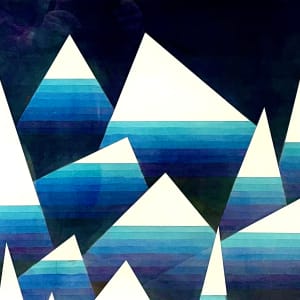
Farquhar McGillivray Knowles (1859-1932)
Farquhar McGillivray Knowles (1859–1932), RCA, OSA, was an American-born Canadian artist renowned for his marine paintings. Born in Syracuse, NY, of Scottish descent, Knowles moved to Canada as a child and initially pursued a military career. After a life-changing accident at West Point, he turned to art, studying under William Merritt Chase in New York and later with John A. Fraser in Canada. In 1889, he was elected an Associate of the Royal Canadian Academy for his skills as a watercolourist. Knowles studied in London and Paris before returning to Canada, where he became a prominent figure in Toronto's artistic community. His works, influenced by Impressionism and the Aesthetic movement, are notable for their authentic atmosphere, especially his marine scenes. Knowles died in 1932, leaving a legacy as one of Canada's respected early artists.
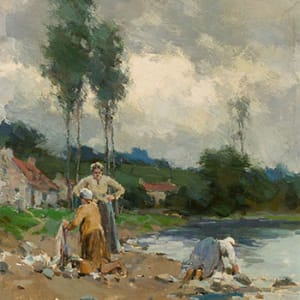
Nicholas de Grandmaison (1892-1978)
Nicholas Raphael de Grandmaison CM RCA (1892–1978) was a Russian-born Canadian portrait artist renowned for his evocative pastel portraits of Indigenous peoples. A former Russian military officer and World War I prisoner of war, he later studied at St. John's Wood School of Art in London before immigrating to Canada in the 1920s.
Settling in Alberta, de Grandmaison dedicated his career to capturing the dignity and spirit of First Nations subjects, earning recognition as a visual historian. His work is held in major collections across North America, including the University of Lethbridge. In 1972, he was appointed to the Order of Canada for his artistic contributions.
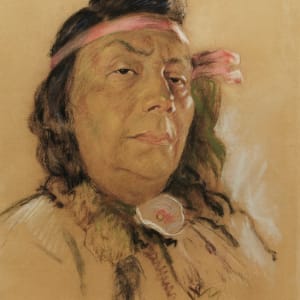
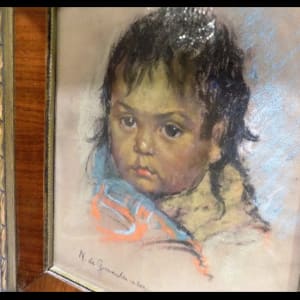
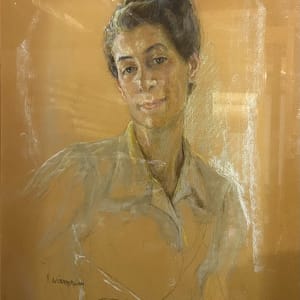
Sydney Hollinger Watson (1911-1981)
S.H. Watson (1911–1981), RCA was a Canadian artist, educator, and muralist known for his contributions to visual arts and design. Born in Toronto, he studied at Central Technical School and worked as a commercial artist before becoming an influential art educator. He served as Principal of the Ontario College of Art (1955–1970), overseeing its expansion into Canada’s leading art school.
Watson was a prolific muralist, creating works for corporate, religious, and public institutions, including the Province of Ontario (1967) mosaic at Queen’s Park. A member of multiple art societies, including the Royal Canadian Academy, his work is housed in major collections such as the National Gallery of Canada and the McMichael Canadian Art Collection.
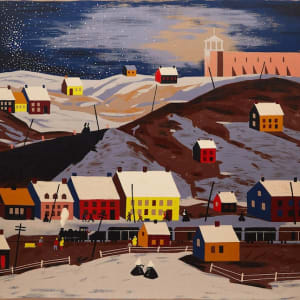
TARAS YURI SNIHUROWYCZ (1918-2011)
aras Yuri Snihurowycz (1918–?) was a self-taught artist and iconographer born in Ukraine. Educated in Europe and Canada, he immigrated to Canada in 1950 and became an Associate Professor at the University of Manitoba's Faculty of Dentistry. Initially a collector of Eastern European, Ukrainian, and Byzantine religious art, he began painting in 1975, focusing on traditional Ukrainian icons. Working primarily in acrylic on wood or chemically antiqued copper with gold leaf, he produced over 200 icons, balancing replication with original compositions. His work was exhibited at various Ukrainian cultural events and government-sponsored exhibitions in Winnipeg, earning praise for its mystical and spiritual qualities.
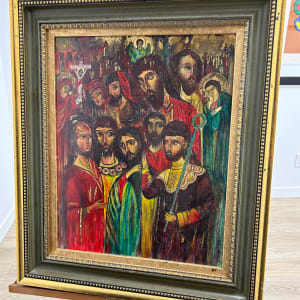
Ronald Threlkeid Jackson (1902-1992)
Ronald Jackson was a Canadian painter known for his evocative marine paintings, often depicting fishing vessels navigating the coastal waters of British Columbia. A graduate of the Slade School of Fine Art in London, he further honed his craft in Paris and Los Angeles.
Jackson received government commissions from Canada, the UK, and British Columbia and was a founding member of the Canadian Society of Marine Artists. His work, blending semi-impressionistic style with maritime realism, is held in collections such as the Royal BC Museum, the Maltwood Museum, and the Whyte Museum of the Canadian Rockies.
